There is nothing quite like
popular culture to make you realise just how much the
paradigms and tastes of any given period change as time
flies by. Comic books, of course, are no exception.
But apart from illustrating how much the medium and its
content have changed, looking back over the years, above
all, also provides substantial insight into how much the
industry and its market have changed.
|
| |
|
| |
| Welcome
back to a little bit of digging and excavating amidst the
artefacts of the world of comic books. This time around
we turn to Gotham City in what might seem like a time
paradox as we take a closer look at Batman #1
from 2011 and Batman #315 from 1979. The simple
explanation for this peculiar number count of Batman lies
with DC's (re)launch of their "New 52" in
September 2011 and the subsequent re-numbering of all of
the monthly comic book titles. 
In-house
ad for DC's "New 52" relaunch
|
| |
| Hence the
premier issue of Batman, which strictly speaking
is thus #1 of volume 2, and which provided readers under
the age of around 80 (i.e. all those who weren't around
in 1940 to pick up the first Batman #1) with an
opportunity to buy and read a first issue of Batman
- the first renumbering DC afforded the title after a run
which had lasted 715 issues. |
| |
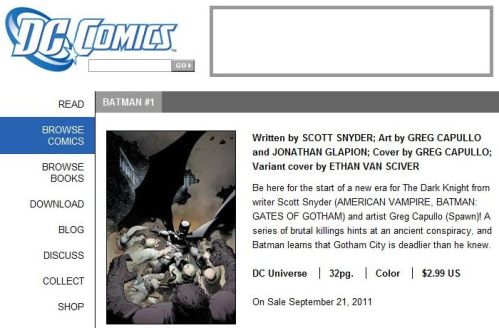
DC Website announcement for Batman
#1
|
|
Apart from that - and in
spite of some high-profile hype from DC - changes
to the form and content of the immediately
preceding last issues of volume 1 were few and
far between (e.g. no origin story whatsoever),
other than the fact that Bruce Wayne was back as
Batman after a Grant Morrison odyssey (i.e.
"story arc") featuring Dick Grayson as ersatz
Batman whilst Bruce Wayne was somehow "cast
back in time" by Darkseid. Whatever -
readers trying to spot any differences would thus
be required to look further back in (real) time -
for example by taking a look at Batman
#315, the cover date of which (September 1979)
separated it exactly 33 years from Batman
#1 which was launched on 21 September 2011
(featuring the usual gap with regards to the
cover date, which in this case was for November
2011).
|
|
| |
| Naturally,
this discrepancy between the actual date of publication
and the date given on the cover (which in modern comic
book times is around 2 months) also held true for Batman
#315. However, for those comic books from DC and Marvel
which were sold in the United Kingdom during the 1970s,
that difference (which generally speaking used to be 3
months during that decade) virtually collapsed due to
shipping times. |
| |
| Seeking out the US comic
books imported for the British market at WH Smith
in Sutton in late
September 1979, I found that the overall
selection of titles from Marvel had shrunk
considerably in comparison to only two years
earlier. At the same time, however, I also
spotted a few DC titles imported for UK retail
for the first time at Smith's. The selection was
small and seemed somewhat odd, but I was more
than happy to come away with Batman #315
(cover date September 1979) alongside Unknown
Soldier #232 (October 1979) and House of
Mystery #272 (September 1979). Unlike
Marvel, which had been shipping its comics to the
UK with specially printed covers almost
continuously since the early 1960s, DC had not
taken up this dedicated distribution channel
prior to the early 1970s as US print run copies
simply received a UK currency price stamp on their
cover.
|
|

WH Smith, Sutton High Street
(September 2007)
|
|
| |
| The first
known examples of printed UK prices on the covers of DC
titles seem to come from 1971, but in any case supplies
were intermittent and unreliable throughout the decade.
In early 1979, however, DC seems to have made a conscious
effort for a while to supply the British market with
dedicated cover printings - although
"dedicated" might be too big a word. |
| |
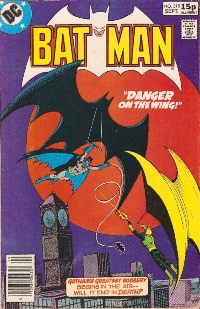
Batman #315
(September 1979)
UK 15p price variant
|
|
Unlike UK covers from Marvel
(where the masthead band MARVEL
COMICS GROUP was changed to MARVEL
ALL-COLOUR COMICS), UK covers
for DC titles only differed with regard to the
price. As a result, the difference in appearance
between the copy of Batman #315 I picked
up at WH Smith's and its US counterpart was
minimal and limited to the price indication.  
UK cover price indication
15p and
US cover price indication 40c
The difference between US and
UK priced DC covers was thus also markedly
smaller than between the regular issue and the
"Whitman variant" of Batman
#315, which features the prominent upper left
corner logo design used by Gold Key (Western
Publishing) for their newsstand distribution.
|
|
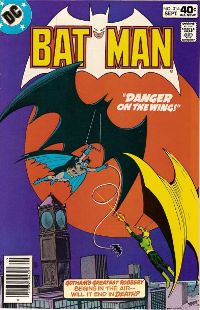
Batman #315
(September 1979)
US market 40c cover
|
|
| |
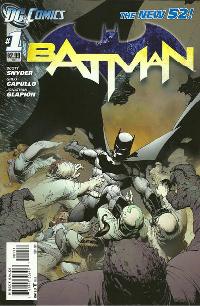
Batman #1
(November 2011)
US $2.99 price only
|
|
Batman #1,
in contrast, only carries a US market
price (which had risen from 40c to $ 2.99
in 32 years). Perhaps most strikingly,
the bat silhouette (which goes back
virtually to the first Batman #1
from 1940) underlying the branding BATMAN
remains virtually unchanged - a clear
indication of the iconicity of the
character. Turning back to 1979,
the facts of comic book distribution were
such that there was no guarantee for
consecutive issues of a given title to
actually show up and be on sale where you
had bought your previous copy.
The ensuing gaps in
continuity were, however, softened to
quite some extent by the fact that this
was the Bronze Age, and you thus stood a
fair chance of not missing anything in
the way of storyline because these were
still very much running on the "one
and done" formula, i.e. where a
story would begin and end in the same
comic book.
|
|
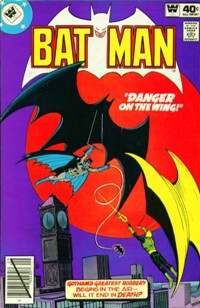
Batman
#315
(September 1979) Whitman variant
|
|
|
| |
| This is
also the case for Batman #315 - "Danger on
the Wing" was written by Len Wein, pencilled by Irv
Novick, inked by Frank McLaughlin, coloured by Glynis
Wein, lettered by Ben Oda and edited by Paul Levitz, and
it kicked off and ended all in this one issue. Batman #315
also displays a perfect example of what used to be the
classic comic book splashpage. Used extensively up until
the end of the 1960s, DC (unlike Marvel) still kept this
"introductory page" (which often performed a
similar function as a movie poster and thus almsot served
as "second cover") in some of its titles
throughout the 1970s.
|
| |
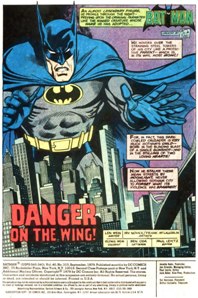
Splashpage Batman
#315 (September 1979)
|
|
This type of
splashpage helps to set the mood and
links the story about to be told to the
origin of the Batman - the darkness of
Gotham triggered the existence of Batman,
and now he stalks the city by moonlight
so that Gotham may never forget what its
violence has spawned... Clearly,
this is still the "1970s dark
knight" period of Batman, although
the villain in this issue (Kite-Man) will
hardly send any shivers down the reader's
back - which is in stark contrast to the
gang of villains out to give Batman a
rough time in Batman #1.
Not so much an
indication of a "dark" Batman
but rather of the fact that this is now
generally a "T" rated comic
book.
|
|
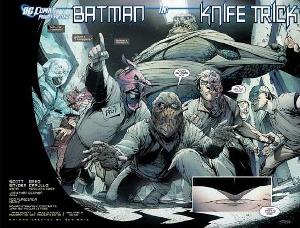
Splash page
double-spread Batman #1
(November 2011)
|
|
|
| |
| The
splashpage from Batman #1 performs an entirely
different function, made clear also by the simple fact
that this double spread covers pages 2 and 3 and not the
first page. And finally, this will be anything but over
by the end of this issue, as this monthly will simply be
the first 32 pages of a trade paperback collecting the
first story arc - and it is this form of publication
which ultimately dictates the length and pacing of the
storyline. In 1979, writing letters to the
editor of a comic book was pretty much the only way
available to readers who wished to make their opinions
heard, and Batman has a long tradition of aptly
named letters pages.
|
| |
 |
| |
| In
September 1979, you wrote in to Bat Signals, but
whilst the letters page had been revived by DC throughout
most of the monthly titles in late 2010, Batman
along with all other titles of the "New 52"
lost this feature again for good upon relaunch. |
| |
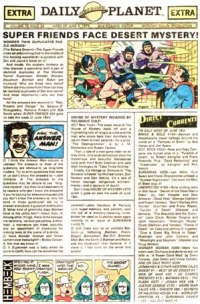
Editorial page from Batman
#315
(September 1979)
|
|
No readers voices therefore
in Batman #1, unlike in Batman
#315, but at least editorial had a voice in both
1979 and 2011. In 1979, the "Daily
Planet" editorial page offered extended
teasers for Super Friends #24 and House
Of Mystery #272, the "Answer Man"
column (which this time around looked into
questions such as what kind of gimmicks were
stowed away in Batman's utility belt or if Wonder
Woman and Green Lantern had ever fought against
each other), a Hembeck cartoon (spoofing the
Spectre and the original Flash), and the
"Direct Currents" overview and
checklist of DC titles on sale the week of June
18th 1979.
This
density of information (and entertainment) is
only just met in Batman #1, even though
editorial content is spread out over three pages
- it would almost seem that the general tendency
towards decompression on the levels of plot and
storytelling have also affected editorial.
|
|
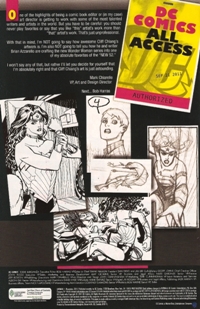
Editorial page "All
Access" from Batman #1 (2011)
|
|
| |
| All three editorial pages in Batman
#1 are concerned with DC's "New 52"
titles and could thus also be seen as being
little more than text-heavy in-house
advertisements. In "DC Comics All
Access" readers are basically offered five
sketches of Wonder Woman for the "New
52" plus a few lines by Art & Design
Director Mark Chiarello which basically plug a
few artists working for some of the "New
52" titles.
The
level of information rises slightly on two pages
of creator interviews, each concerned with the
author and artist of one specific title (in this
case Red Hood and the Outlaws and Blue
Beetle). The teams answer to the same set of
questions, but again - what could potentially be
an interesting comparison leans rather heavily
towards an all-out plug for the "New
52". Overall, readers got more information
on one page in 1979 than they did on three in
2011.
Readers
also got more advertisments in their comic books
back in 1979, although this would of course
hardly rate as a positive with many. In 2011, ads
are all full or even double page, which was
already becoming a predominannt format in 1979,
although half-page ads could also be found whilst
the classic "flea market" ads page from
the 1970s was down to one single page in Batman
#315.
|
|
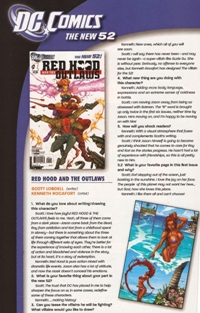
Editorial page "The New
52" (one of two pictured here) from Batman
#1 (2011)
|
|
| |
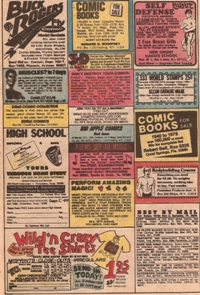
Ad page from Batman
#315 (September 1979)
|
|
That specific page
still featured ads for means of building
up muscle and acquiring some sort of high
school diploma, but already ads from
comic book stores selling current and
back issues were appearing. In 2011, one
such company grabbed an entire page to
advertise their services. Possibly
one of the most striking differences
between these two comic books lies - not
surprisingly - in the artwork. However,
these differences illustrate the changes
in technique more than any changes in
artistic style. Whilst these have also
occured, the computer based production
methods really make themselves felt when
looking, for instance, at the colouring.
This is, of course,
further enhanced and accentuated by the
use of higher grade paper by comic book
publishers since the mid-1990s, which has
greatly improved the artwork and colour
rendition.
|
|
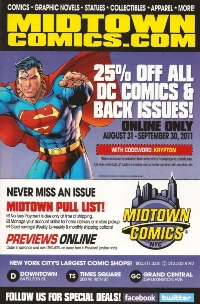
Ad page from
Batman #1 (November
2011)
|
|
|
| |
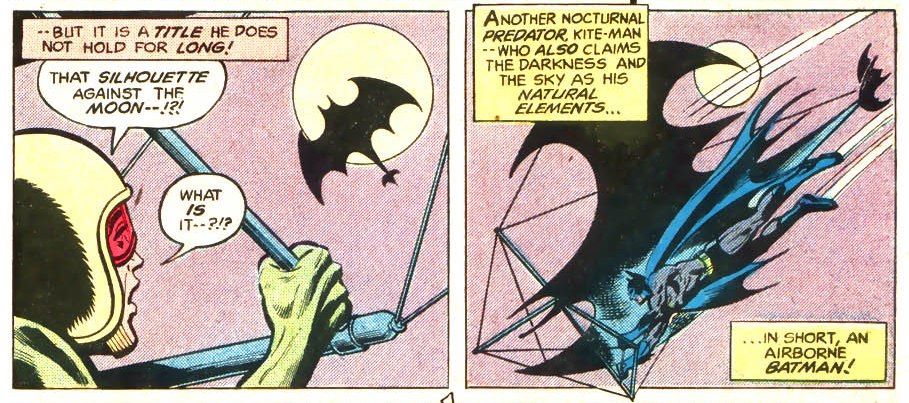
Pencils
by Irv Novick, Inks by Frank McLaughlin, Colours by
Glynis Wein - Batman #315 (September
1979)
|
| |
| Whilst the
printing in Batman #315 cannot be said to be
bad, there is still a certain amount of blurred inking
rendition and colour bleeding. |
| |
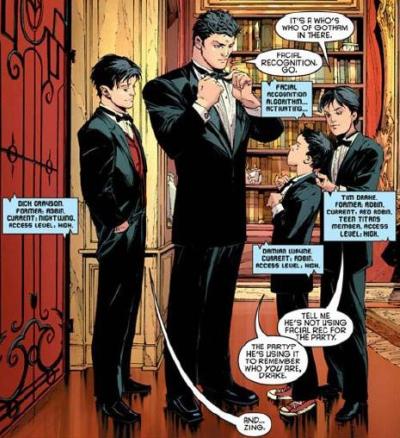
Pencils by Greg
Capullo, Inks by Jonathan Glapion, Colours by FCO
Plascencia- Batman #1 (November
2011)
|
|
The current use of high
quality glossy paper, on the other hand, which
has been chemically de-pulped and coated with an
alkaline buffer, produces superb quality
renditions of artwork and colours, and thus does
the efforts of the creative teams justice and
provides a faithful rendition of their work,
whilst the printing from 1979 does have its
limits in that respect. Obviously,
such improvements will be reflected in the price
of a product, and the rise from 40c (or 15p)
needed to purchase Batman #315 in 1979
to the $2.99 it cost anyone wishing to read Batman
#1 in 2011 is a sharp one. This is accentuated
further when taking into consideration that the
purchasing power of 40c for commodities in 1979
equals $1.20 in 2010 when using the consumer
price index; in terms of
"affordability", spending 40c on a
comic in 1979 equals spending an amount of $1.65
in 2010 (measureworth.com).
What
these figures indicate is that today's improved
paper and printing quality comic books are
roughly twice as expensive as they used to be in
1979. But regardless of the differences in their
respective production qualities and selling
price, Batman #315 and Batman
#1 share the similarity of both having been
published during a period of relative gloom for
the comic book industry.
|
|
| |
| In 1979,
the market for comic books shrunk to an all-time low
(Daniels, 1991), and DC still felt the shock of the
abrupt cancellation of around 30 titles (the so-called
"DC Implosion") in September 1978. 2011, on the
other hand, had started out as an especially lean year in
terms of sales, following a string of years which
themselves had seen a constant decrease sales figures. In
February 2011 (according to figures released by Diamond
Distribution) Green Lantern #62 was the best
selling monthly comic book in North America with a mere
71,517 copies, making it the lowest selling number one in
years. It took an exceptional corporate mega-event such
as DC's "New 52", in which Batman #1
plays an important part; only by including this
established title along with the likes of Detective
Comics, Action Comics and Superman
in the general number reset to 1 could DC claim an
all-across-the-board event which would attract the
widespread attention it finally did. Accordingly, sales
figures virtually exploded in comparison to the year's
previous statistics, and Batman #1 became the
best-selling comic book of September 2011 with an
impressive total of 188,420 copies - also giving DC its
first market share victory over Marvel in years. Even though the
"New 52" have helped boost the sales of comic
books in general, this is of course nowhere close to
where sale figures once were. According to the
circulation figures reported to the US Post Office, Batman
comic books sold an average 502,000 copies per month
in 1960, and sales figures even rose to 898,470 copies
per month in 1966 as a result of the popular tv show. The
big slump came in the 1970s, when sales dropped to
293,897 in 1970 and decreased further throughout the
decade. Whilst the sales figures of 1979 (166,640 copies
on average per month) are not too far away from the
188,420 copies sold of Batman #1, their
background could not differ more - the sales figures of
1979 were at the end of a constant decline, whilst the
sales figures of Batman #1 and other "New
52" titles were a rocket blast out of a market
misery.
The constant
decline in sales and profits throughout the 1970s finally
led to the creation of the "direct
market", which is generally credited with having
saved the comic book industry from almost certain death
(Groth, 2006). It created the specialist comic book shop
as the main point of sale ("direct
distribution"), thus streamlining the distribution
system and doing away with the returns system whereby
newsagents could return any unsold copies and get
refunded, i.e. a business model which did nothing to
encourage actual sales (Groth, 2006). The direct market
changed the entire system of comic books, and whilst it
helped to prevent worse, it also meant by definition that
comic books would be mostly "hidden" from the
general buying public.
|
| |
| Therefore, whilst I was able
to buy Batman #315 at a WH Smith store
in 1979, they did not carry Batman #1 in
2011, in spite of the fairly wide public coverage
DC's "New 52" received. However,
this did not mean that anyone eager to pick up a
comic book featuring Batman would need to leave
WH Smith empty handed. Rather surprisingly, there
even was a wider and far more varied choice in
comparison to 1979 (when you could get issue #315
only), with the UK reprint Batman Legends
#49 on sale as well as a wide choice of trade
paperbacks (TPB) featuring the Darknight
Detective, such as Batman: The Black Casebook
(2008) or Batman: The Strange Deaths of Batman
(2008), along with the omnipresent Killing
Joke (various editions since 1988).
Oddly
enough, in terms of Batman, the direct market has
had no influence on the availability of material
at WH Smith's other than the actual US monthly
comic book. No doubt this says a lot about the
iconic status and household name of Batman. And
whilst there could have been no certainty for the
teenage reader who picked up Batman #315
in September 1979 that there would also be a new
issue of Batman on offer in September
2011, somehow it always seemed clear beyond a
doubt that Batman would be around for, well, for
ever.
|
|
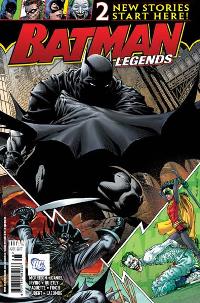
UK Batman Legends #49
(September 2011)
|
|
| |
| The last
question to be raised here therefore is - what will Batman
look like after another 32 years? Assuming that DC
will pick up the original numbering again (which stopped
at #715 in August 2011) somewhere down the road, that
would be around issue #1100. And oh, one last
thing - if you thought the "bat glider" used by
Batman in issue #315 to bring down Kite-Man was typical
1970s comic book old-tech... well, think again. And take
a look at this scene from Batman #3 (cover date
January 2012, out in November 2011). There you go - now
that you've read this write-up, you can really put that
scene into perspective.
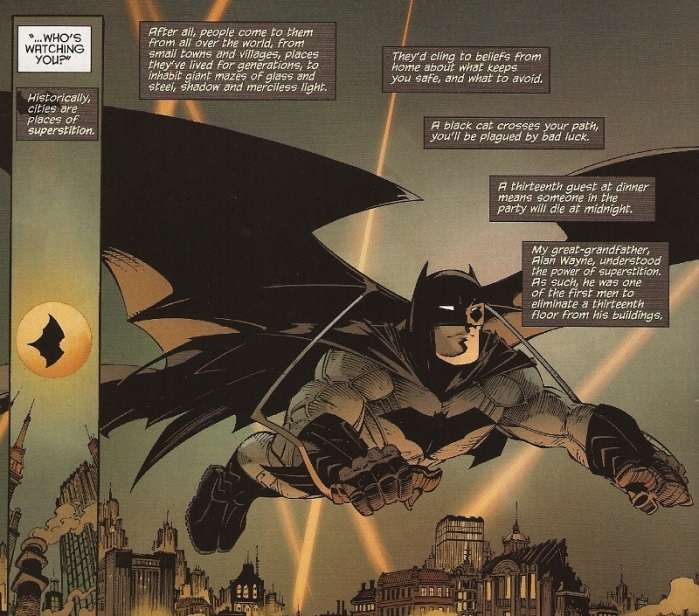
|
| |
|
| |
BIBLIOGRAPHY
DANIELS Les (1991) Marvel:
Five Fabulous Decades of the
World's Greatest Comics, Harry N.
Abrams, Inc.
GROTH Gary (ed.,) (2006) The
Comics Journal #277 (July 2006),
Fantagraphics
|
| |
|
| |
|

